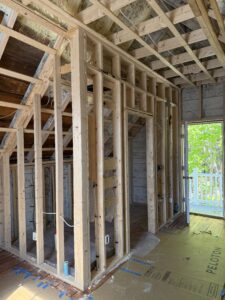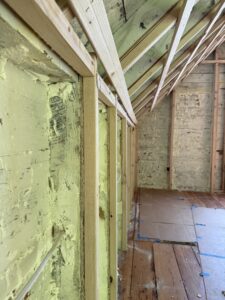When we talk about architecture and design, most people think of open layouts, natural light, or finishes and materials. But before the paint goes on the walls, there’s one critical system that shapes how a home feels and performs throughout the day, and that is insulation.
While not glamorous, insulation is essential in keeping your home warm in the winter, cool in the summer, and efficient all year round. Let’s take a look at what insulation is, how it fits into the construction process, and what can go wrong without proper planning.

What is Insulation?
In simple terms, insulation slows the transfer of heat through walls, ceilings, and flooring. It plays an important role in temperature control, moisture resistance, soundproofing, as well as meeting building codes. Common types of insulation include:
- Fiberglass batts are budget-friendly, easy to install, but have lower R-value per inch.
- Spray foam expands to fill cavities and provides both insulation and air sealing.
- Rigid foam boards have high thermal resistance, often used in walls, roofs, and foundations.
- Blown-in cellulose is ideal for irregular spaces and often made from recycled materials.
Before insulation is installed, all the “rough-in” work must be completed. That means all plumbing lines, electrical wiring, and HVAC ductwork should already be in place within the wall cavities. Framing should be finalized, and all windows and doors must be installed and properly sealed. At this point, the structure is essentially weather-tight, and the systems that need to live inside the walls are in their final positions.
Once insulation is in place, the project can move forward with drywall, painting, trimwork, and flooring (the visible layers that make a space feel finished). But how well the insulation actually performs comes down to how effectively it resists heat transfer, and that’s measured by its R-value.
What’s an R-Value?
R-value measures thermal resistance and it’s how we compare different insulation materials and ensure they meet modern energy standards. Basically, the higher the R-value, the better performance. In New England for example, exterior walls typically need at least R-21, while roofs might require R-49 or more. If framing isn’t deep enough to accommodate the required insulation, it may need modification, or you risk inspection failures and long-term energy issues.

Why Insulation Matters
You don’t have to be a contractor or architect to understand the importance of insulation. It’s something that every homeowner should know at least a little about, since it directly impacts how your space functions and feels.
Here is why insulation matters:
- It keeps interior temperatures consistent, reducing strain on HVAC systems.
- It lowers monthly energy bills and reduces a home’s carbon footprint.
- It minimizes noise between rooms and floors.
- It’s essential for meeting local and national building codes.
- It can affect home resale value and long-term durability.
Project Setback: Rye Barn Renovation
On a recent renovation in Rye, New Hampshire, we ran into a hiccup that highlights just how important insulation planning can be. The project involved converting the upper level of an existing barn into conditioned living space, complete with a full-sized bathroom. The barn had its original 2×4 wall framing, and the builders subcontracted spray foam installers to insulate before the drywall and finish work could begin.
But once spray foam installation began, it became clear that the shallow framing couldn’t accommodate the insulation depth required to meet building code. To fix the issue, the builders had to remove the spray foam, “fir out” the studs to create 2×6 framing, and then bring the spray foam team back to re-insulate.
Fortunately, the problem was caught early and resolved within a few days, but it’s a good example of how even small oversights can result in costly and time consuming delays.


As we saw in our Rye Barn Renovation, careful planning and clear communication between clients, designers, and builders is essential. So whether you’re building, renovating, or designing, don’t underestimate what’s inside the walls, it plays a bigger role than you might think. If you’d like to talk more about insulation in your home, book a free 15-minute consultation with us to get the conversation started!
